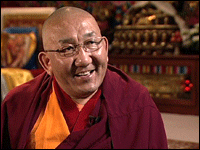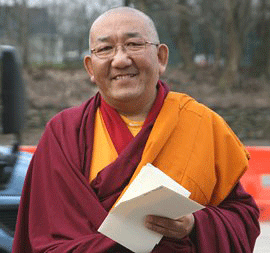 St. Paul, Minnesota – Promoting his hair-raising memoir as a reincarnate monk and a top official in the Chinese-ruled Tibet, Arjia Rinpoche – one of the most important Tibetan Buddhist leaders to escape Tibet after the His Holiness the Dalai Lama in four decades– recounted the story of his life to the Tibetan community of Minneapolis.
St. Paul, Minnesota – Promoting his hair-raising memoir as a reincarnate monk and a top official in the Chinese-ruled Tibet, Arjia Rinpoche – one of the most important Tibetan Buddhist leaders to escape Tibet after the His Holiness the Dalai Lama in four decades– recounted the story of his life to the Tibetan community of Minneapolis.
Rinpoche was in the Twin Cities to promote his book, Surviving the Dragon: A Tibetan Lamas Account of 40 years under the Chinese rule, published earlier this year.
He said that even though he held a very high position in the echelons of the Chinese Communist leadership, he had to toe the government’s line on all matters
In the end, however, he said, he could not violate his inner conscience. The final straw that triggered Rinpoche’s decision to eventually flee into exile was the Chinese government’s invitation to become the tutor of the surrogate incarnation of Panchen Lama, Gyantsen Norbu.
“This is a work that I can never agree myself to perform,” he said to a crowd of nearly 60 people.
On November 29, 1995, Rinpoche was asked to attend the selection ceremony inside the Dalai Lama’s ancient palace, Potala, organized by the Tibetan Autonomous Region. He said as the top leaders of the Chinese communist party and several lamas sat in the front row as the monks performed the Golden Urn Ceremony inside the Jokhang Temple, the sanctum sanctorum of the Tibetan Buddhism.
According to the Tibetan tradition, names of the finalists were put in a huge golden bowl from which the winner is picked. He said that selection of Gyantsen Norbu was a faked by the Chinese authorities.
Despite the material comforts and perks, which came with his high position, his life had become intolerable because of the Chinese politics.
“Now I had reached a station in life that seemed the pinnacle of worldly success, and I found myself trapped in bureaucratic quicksand,” he writes in the book. “My life was betraying my religious and moral principles.”
When Rinpoche left China, he held a total of five major positions in China. They included deputy chairman of the Buddhist Association of China, member of the NCCPPCC, deputy chairman of the All-China Youth Federation, chairman of the Qinghai Buddhist Association of China, deputy chairman of the Qinghai Provincial Committee of Chinese People’s Political Consultative Conference, and dean of the Tibetan Buddhist College of Qinghai Province.
Rinpoche believed that one of the reasons why he was promoted so rapidly to the highest levels of Beijing’s leadership is because of his Mongolian ancestry. He surmised that perhaps they hoped that his Mongolian heritage might make him less sympathetic towards Tibetans than those who are purely ethnic Tibetans.
Rinpoche said he found himself in a dilemma: whether to follow the directives of the Chinese government or to suffer the consequences for his disobedience. In the end, while weighing options, he was reminded of an advice by one of his teachers, Gyayak Rinpoche, who had counseled him to retire from politics and seek a life of spirituality at the age of 50.
Finally, he chose the middle way and made preparations for his escape. In 1998, at the age of 48, he braced tremendous security risks to flee Tibet with four of his attendants. They flew from Beijing to Guatemala, which did not have a diplomatic relations with China and thus lacked an embassy in Beijing. Rinpoche and his entourage was granted visa on arrival by Guatemalan authorities.

After two months, he arrived in the United States. He met with His Holiness the Dalai Lama who was on a visit to New York and received Lamrim teachings. His Holiness recommended a spiritual teacher, Geshe Sopa, a retired professor at the University of Wisconsin. His Holiness the Dalai Lama even asked him to write a letter to the Chinese leadership, hoping that he might be able to become a bridge between the Tibetans and the Chinese.
He established a Buddhist center in the Tibetan Center for Compassion and Wisdom in Mills Valley, California.
Rinpoche was recognized at the age of two as the reincarnation of the previous Arjia Rinpoche. He was later made into an abbot of Kumbum monastery, the alma mater of the Dalai Lama’s elder brother, late Taktser Rinpoche.
In 2010, His Holiness the Dalai Lama asked Arjia Rinpoche to take charge of of the Tibetan center in Bloomington, Indiana, which was later renamed as the Tibetan Mongolian Buddhist Association.
His memoir has already been translated into Mongolian. He is currently translating it into Tibetan. He plans to include more information about the previous Panchen Lama into the Tibetan edition of the book. He said his American editors had cut some portion of the book from the English edition, fearing that it might bog down or bore the readers. He also hopes that the book will be published in Mandarin.
In the final analysis, he said the book, which took him six years to write, will educate and inform the outside world about the life he had led under the Chinese rule in Tibet. He said that half of the proceeds of the sale of the book would go to the reconstruction efforts of the earthquake that struck Kyikudo in April and other half into the construction of a proposed hospital in outer Mongolia.
Tibetan residents of Minneapolis were very enthusiastic about the book. Book was on sale at the venue and many lined to have them autographed by Arjia Rinpoche. They offered him ceremonial scarves. Many bought several copies of books, some of them clutching multiple copies between arms.
On this tour, apart from Tibetan American Center of Minnesota, Rinpoche was scheduled to speak at the Barnes and Nobles, Hindu Temple and the Heart of Tibet.
Author : Tsering Namgyal
Source : http://www.phayul.com




